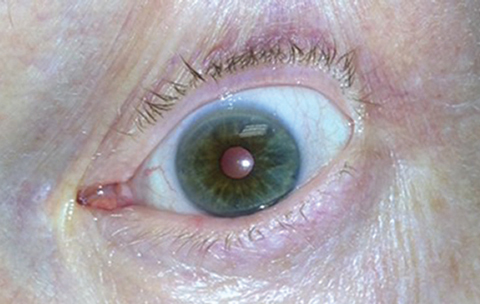 |
| Three cases of retinal detachment associated with use of pilocarpine eye drops were identified in this study. Photo: Michael Trottini, OD, and Michael DelGiodice, OD. Click image to enlarge. |
Editor’s Note: As part of our “Year in Review” retrospective, we’ve selected the top 30 news stories of the year and are re-sharing them as we close out 2022. Follow along as we count down to number 1!
This story was originally published on May 26, 2022.
No. 12 biggest news story of 2022:
Since the recent FDA approval of Vuity—the first eye drop on the market to treat presbyopia, with more to follow—patients and doctors alike have been showing an increasing level of interest in the clinical value of its active ingredient, pilocarpine. The new use for this long-standing ophthalmic pharmaceutical attracts many users and providers due to its potential to eliminate the need for glasses or contact lenses. Though the treatment has proven safe and effective in various clinical trials, research must continue to investigate possible risks and clinical indications of topical pilocarpine use.
A recent multicenter case series identified a possible association between the risk of retinal detachment and the use of pilocarpine eye drops. The research team identified three cases of retinal detachment in two patients using topical pilocarpine as presbyopia treatment. They hypothesized that the drug may cause anterior lens migration, which could transmit tractional forces on the retina.
The first patient, a 47-year-old male presbyope, had been using pilocarpine 1.25% drops for one month before presenting complaining of bilateral flashes and floaters that had been intensifying since days after treatment initiation. Upon dilated examination, the doctor observed “an inferotemporal retinal detachment in the right eye with an associated retinal tear inferotemporally.” In addition, the study noted that the patient’s left eye “demonstrated a retinal detachment in the superior quadrant with an associated horseshoe tear at 12 o’clock.”
The second patient, a 46-year-old male presbyope, presented at a retina clinic five weeks after initiating pilocarpine 1.25% use complaining of a nasal visual field defect that had started to affect his central vision. The researchers noted that this patient’s dilated exam showed “a superior retinal detachment from 11 to three o’clock with subretinal fluid extending into the macula.”
While no causation can be determined between the new presbyopia therapeutic and cases of retinal detachment, the researchers pointed out that “the incidence shortly after initiation of treatment is concerning.” They continued, “Particularly, the occurrence of a bilateral concurrent retinal detachment in the first patient case who became symptomatic with flashes and floaters just three days after starting the pilocarpine 1.25% topical drops warrants further investigation of retinal detachments as a possible adverse effect of treatment.”
Pilocarpine is a miotic, a drug class long been suspected of putting patients at higher risk for retinal detachment, especially in those with myopia or retinal degeneration. In fact, the FDA label for pilocarpine 1.25% includes a warning about a possible risk of retinal detachment due to miotics in “susceptible individuals and those with pre-existing retinal disease,” although no special screening or exams are currently required before writing these patients a prescription.
Based on the information from these three cases of retinal detachment following topical pilocarpine use, the researchers suggested the link between the two should be explored in future studies. In addition, they recommend screening patients to determine if they are at a higher risk for retinal detachment before prescribing pilocarpine for presbyopia, as well as informing patients on symptoms of retinal tears or detachment.
Al-khersan H, Flynn HW Jr., Townsend JH. Retinal detachments associated with topical pilocarpine use for presbyopia. Am J Ophthalmol. May 20, 2022. [Epub ahead of print]. |

